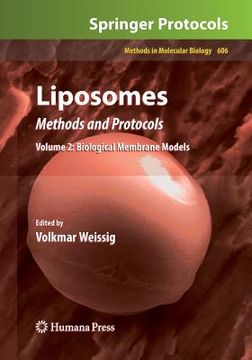Compartir
liposomes: methods and protocols, volume 2: biological membrane models (en Inglés)
Volkmar Weissig
(Ilustrado por)
·
Humana
· Tapa Blanda
liposomes: methods and protocols, volume 2: biological membrane models (en Inglés) - Weissig, Volkmar
$ 197.749
$ 247.186
Ahorras: $ 49.437
Elige la lista en la que quieres agregar tu producto o crea una nueva lista
✓ Producto agregado correctamente a la lista de deseos.
Ir a Mis Listas
Origen: Estados Unidos
(Costos de importación incluídos en el precio)
Se enviará desde nuestra bodega entre el
Jueves 27 de Junio y el
Jueves 11 de Julio.
Lo recibirás en cualquier lugar de Argentina entre 1 y 3 días hábiles luego del envío.
Reseña del libro "liposomes: methods and protocols, volume 2: biological membrane models (en Inglés)"
Efforts to describe and model the molecular structure of biological membranes go back to the beginning of the last century. In 1917, Langmuir described membranes as a layer of lipids one molecule thick [1]. Eight years later, Gorter and Grendel concluded from their studies that "the phospholipid molecules that formed the cell membrane were arranged in two layers to form a lipid bilayer" [2]. Danielli and Robertson proposed, in 1935, a model in which the bilayer of lipids is sequestered between two monolayers of unfolded proteins [3], and the currently still accepted fuid mosaic model was proposed by Singer and Nicolson in 1972 [4]. Among those landmarks of biomembrane history, a serendipitous observation made by Alex Bangham during the early 1960s deserves undoubtedly a special place. His fnding that exposure of dry phospholipids to an excess of water gives rise to lamellar structures [5] has opened versatile experimental access to studying the biophysics and biochemistry of biological phospholipid membranes. Although during the following 4 decades biological membrane models have grown in complexity and functionality [6], liposomes are, besides supported bilayers, membrane nanodiscs, and hybrid membranes, still an indisputably important tool for membrane b- physicists and biochemists. In vol. II of this book, the reader will fnd detailed methods for the use of liposomes in studying a variety of biochemical and biophysical membrane phenomena concomitant with chapters describing a great palette of state-of-the-art analytical technologies.
- 0% (0)
- 0% (0)
- 0% (0)
- 0% (0)
- 0% (0)
Todos los libros de nuestro catálogo son Originales.
El libro está escrito en Inglés.
La encuadernación de esta edición es Tapa Blanda.
✓ Producto agregado correctamente al carro, Ir a Pagar.

